Tom's Guide Verdict
Sony's new Xperia XZ2 is a viable alternative to the assortment of look-alike Android flagships, even if it doesn't necessarily offer the best value.
Pros
- +
Unique design
- +
Fast performance
- +
Great battery life
Cons
- -
Dynamic Vibration is a gimmick
- -
Poor fingerprint sensor placement
- -
Full-HD super-slow-mo clips are too short
- -
Underwhelming low-light performance
Why you can trust Tom's Guide
It's about time. After a string of underwhelming flagship smartphones marred by spiritless design and a deficit of essential features, the Xperia XZ2 is an earnest show of progress for Sony's mobile division. The result is a 5.7-inch handset that rights many of the sins of its predecessors. The Xperia XZ2 is Sony's best phone in years — it's a device that can stand tall among its Android peers, including devices from the likes of Samsung and Google or those from up-and-comers like Huawei and OnePlus.
But can the Xperia XZ2 supplant those phones? That's a tough question to answer. For all its modern touches, the Xperia XZ2 is still an unmistakably Sony product, with all the quirks — good and bad — that come with that identity. This phone has a full suite of weird gimmicks with dubious value, packed inside a pillowy glass body that rebels against the relentless pursuit of ever-slimmer slabs of metal.
This is a premium phone that feels different, but in an unfussy, unflashy way. The Xperia XZ2 can't compete with the Galaxy S9's jack-of-all-trades appeal, the Pixel 2's sublime camera or the unbelievable value of OnePlus phones like the recently discontinued OnePlus 5T. But like those devices, it nails the basics — and that makes it a worthy alternative for those who aren't satisfied with the status quo.
Price and Availability
The Xperia XZ2 is available unlocked from Best Buy for $799, though Amazon is also expected to offer the phone at a later date. Like most unlocked phones, the Xperia XZ2 is exclusively compatible with GSM networks, such as T-Mobile and AT&T. There's only one configuration — 4GB of RAM paired with 64GB of storage — though the device's microSD slot supports memory cards up to 400GB. The Xperia XZ2 comes in four colors: Liquid Black, Liquid Silver, Deep Green and Ash Pink, which we've tested here.
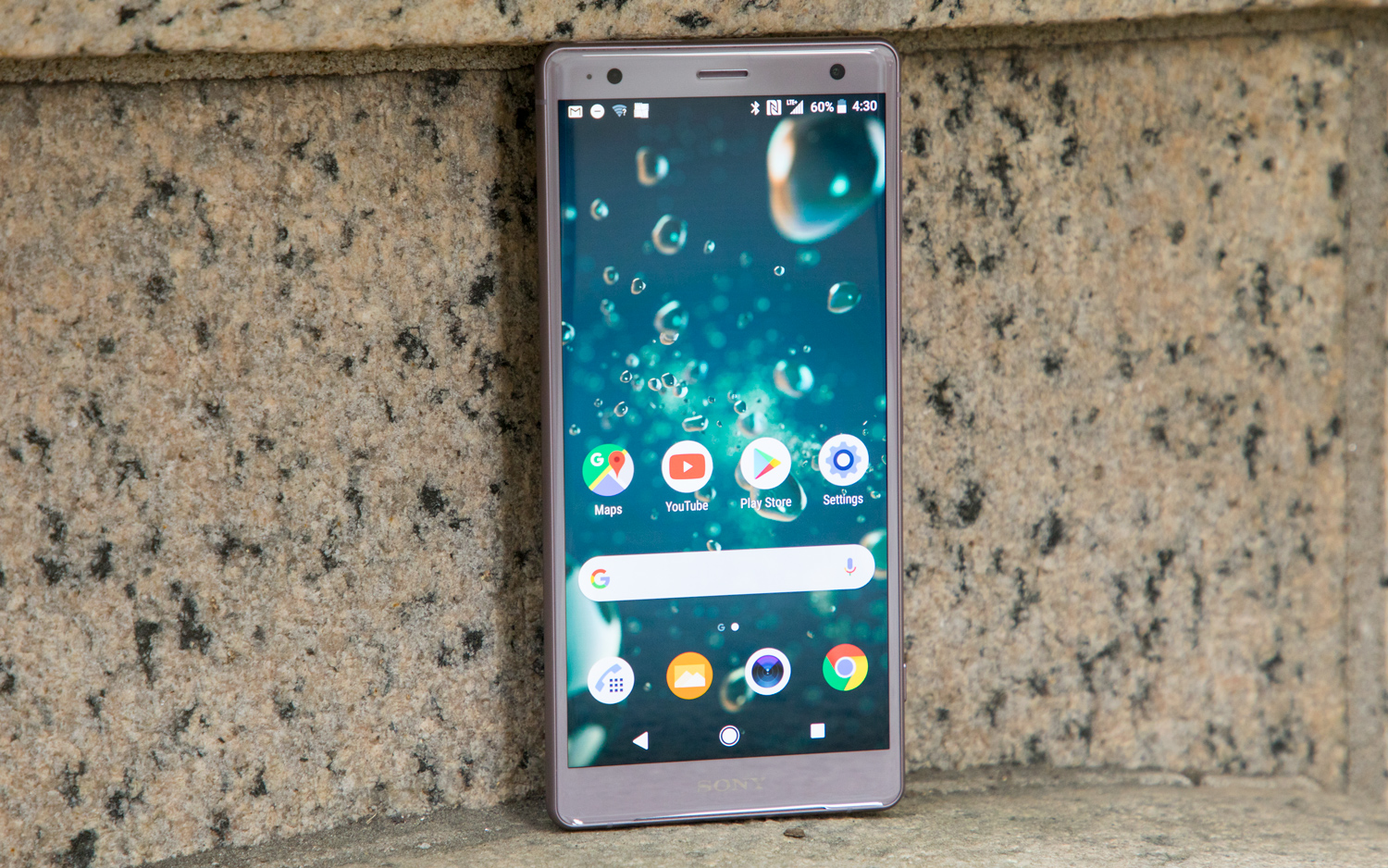
Alternatively, those who prefer smaller devices will be pleased to know that Sony has continued its tradition of delivering a shrunken variant of its latest flagship, called the Xperia XZ2 Compact. This phone retails for $649 and is exactly the same as the standard model from a hardware perspective, save for its design, 5-inch display and lack of Qi wireless charging and Dynamic Vibration motor. We plan to review that model at a future date.
Sony Xperia XZ2 Specs
| Price | $799 |
| OS | Android 8.0 Oreo |
| Screen Size (Resolution) | 5.7-inch LCD (2160 x 1080) |
| CPU | Qualcomm Snapdragon 845 |
| RAM | 4GB |
| Storage | 64GB |
| microSD Slot | Yes |
| Rear Camera | 19 MP, f/2.0 |
| Front Camera | 5 MP, f/2.2 |
| Battery Size | 3,180 mAh |
| Battery Life (Hrs:Mins) | 11:47 |
| Water Resistance | IP68 |
| Size | 6.02 x 2.83 x 0.44 inches |
Design: A step forward and back
With the Xperia XZ2, Sony has finally retired its OmniBalance design style, which was heavily based in minimalism and symmetry and graced every one of the company's phones from 2013's Xperia Z up until now.
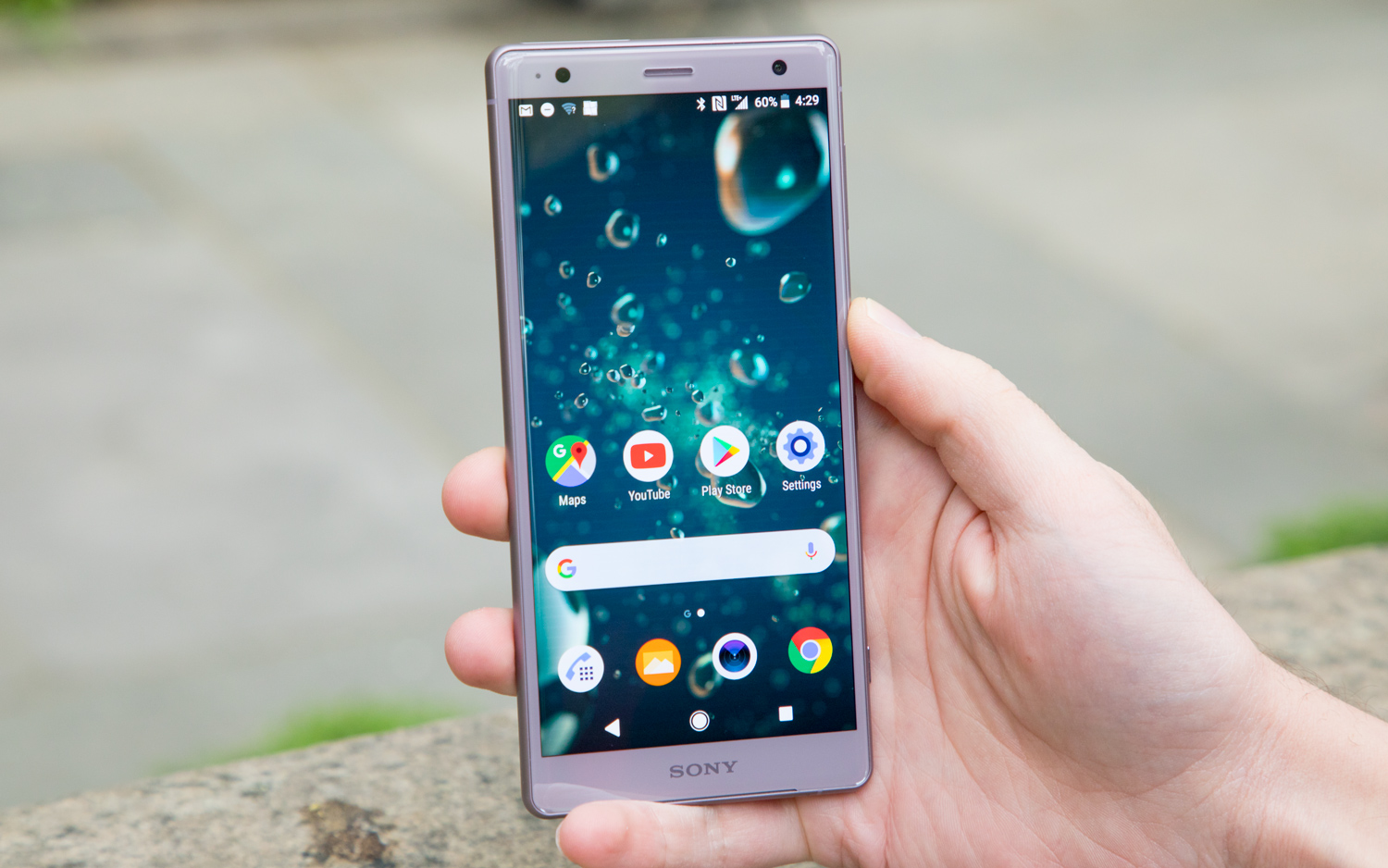
It's not a moment too soon, either. Last year's Xperia XZ1 was a solid, well-built handset, though its sharp, diamond-cut edges and laughably massive bezels made it unwieldy to use with one hand. The XZ2 is the complete opposite: supple and curvy, with a domed glass back and rounded corners that help the device better fit the curvature of your palm.
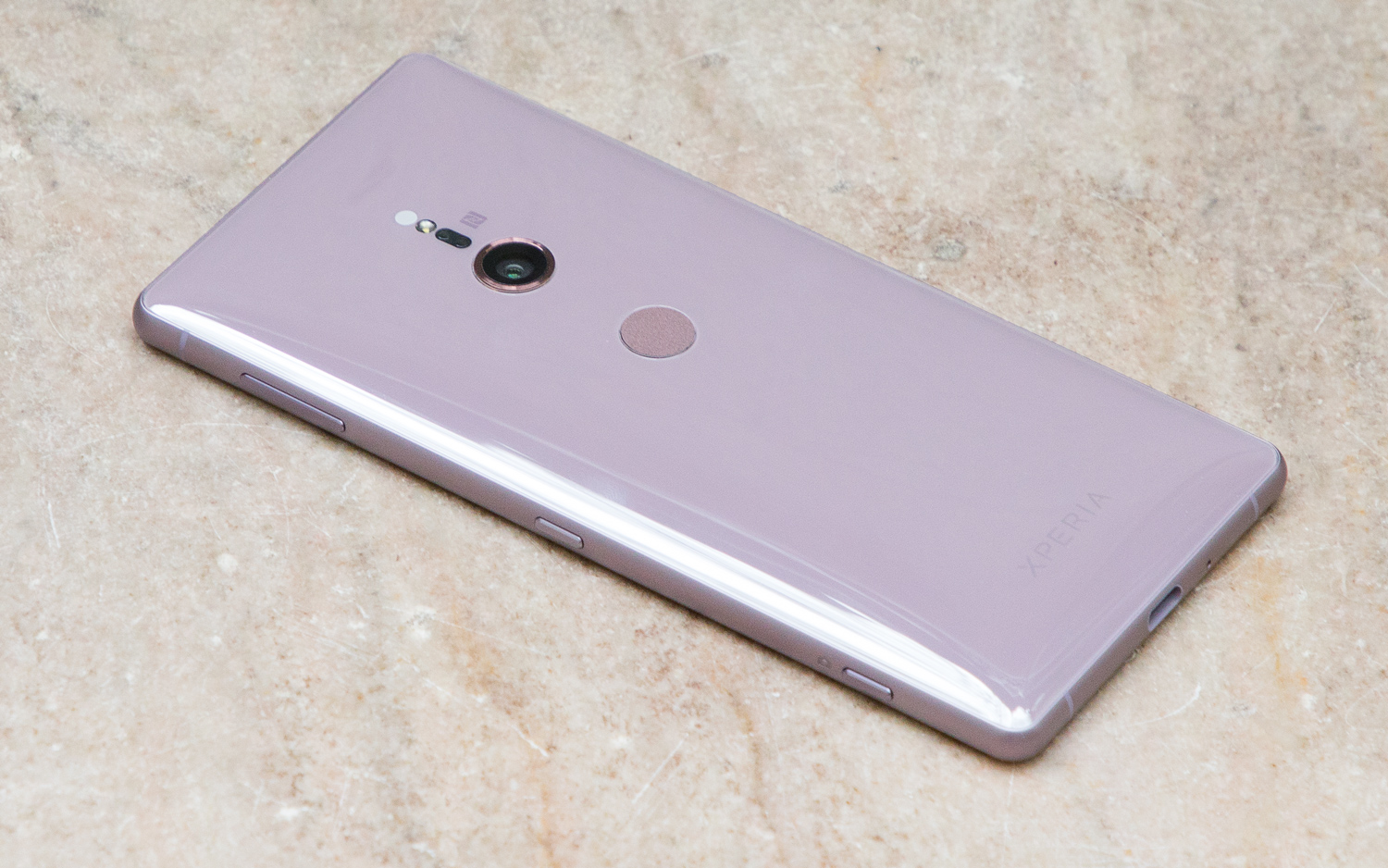
On the front, the XZ2 is dominated by a tall, 18:9 display surrounded by bezels that are reasonably slim but not as minimal as those of the Galaxy S9. Mercifully, Sony hasn't copied the iPhone X's notch as so many phone-makers have been eager to do, and the newest member of the Xperia family is a much cleaner-looking device for it (and, ironically, a more distinctive one, too).
If you thought the Galaxy S8's fingerprint sensor placement was obtuse, you're not going to like the Xperia XZ2's.
The XZ2 is also Sony's first phone to ship in the U.S. with a fingerprint sensor, at long last closing a perplexing gap in the company's feature portfolio. Nevertheless, I'm dismayed to report that Sony's execution still misses the mark. The scanner is now on the back of the phone, as you'd find on most Android handsets. But in an effort to stop users from having to reach too far, the sensor has been placed near the center of the body and much lower than on other devices.
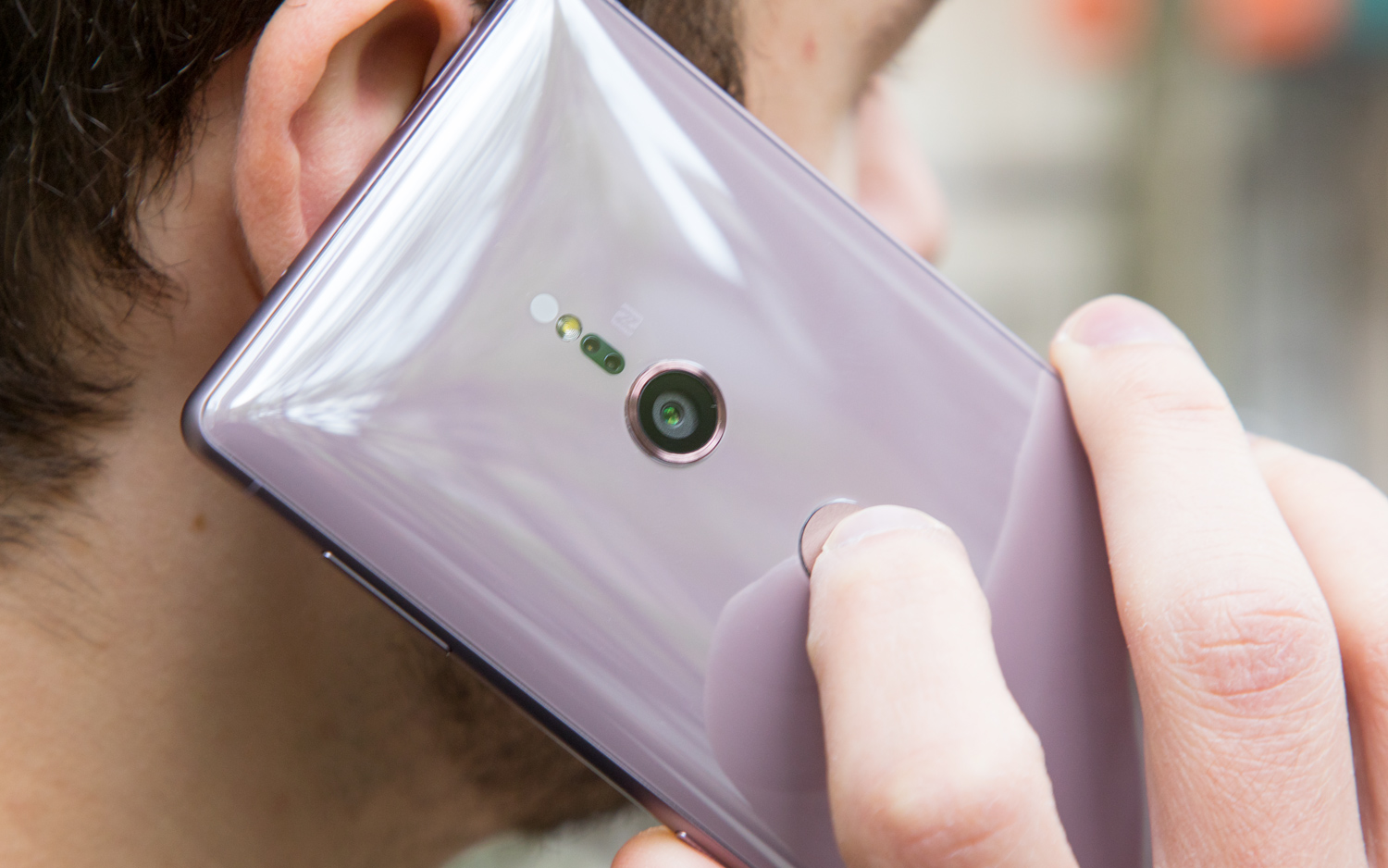
Within seconds of using the XZ2 for the first time, I immediately became aware of the folly of this decision. I'd call my hands average-size, and even I have to awkwardly curl my index finger around to press on the sensor when trying to cradle the phone with one hand. In both hands, it's a little more comfortable, but you shouldn't need to use two hands to unlock your phone.
MORE: Best Smartphones on the Market Now
To make matters worse, the single camera lens is exactly where you'd expect the fingerprint sensor to be. And it's the same diameter. And it's encircled in trim that comically makes it much easier to locate. If you thought the Galaxy S8's scanner placement was obtuse, you're going to love smudging the XZ2's shooter ad infinitum until the muscle memory kicks in to avoid it.
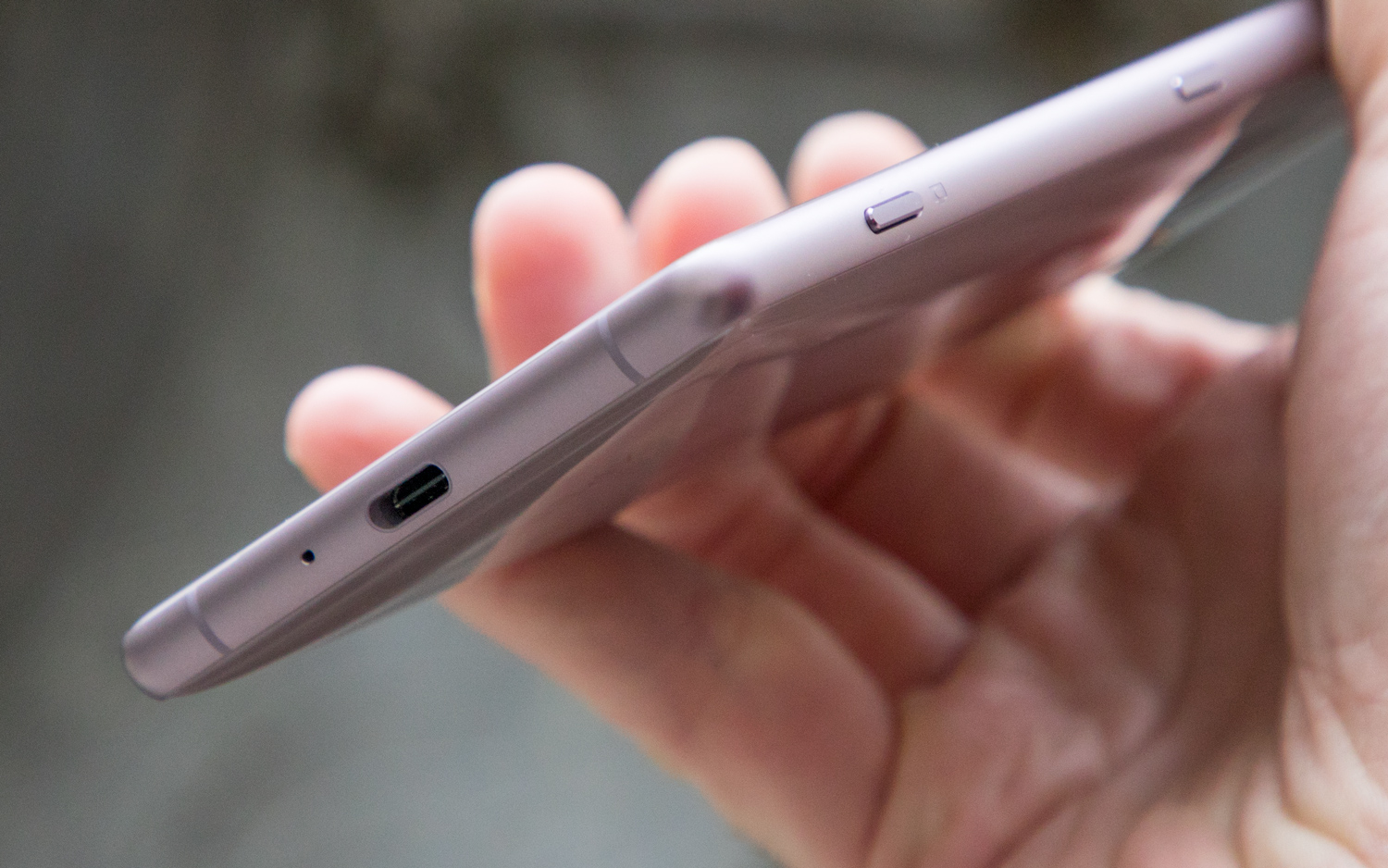
Sony also loses points for creating the slipperiest smartphone I've ever encountered. Because of the curvature of the glass back, the XZ2 will never sit still on an even surface without slowly spinning in place first. It's a good reason to spring for a case, though. Android devices outside of Samsung's flagships tend to have terrible accessory support — so good luck finding one.
Display: The best of the rest
While Sony has gone to great lengths to make the exterior of the Xperia XZ2 look less dated, the same consideration hasn't been extended to the 5.7-inch display under that big sheet of Gorilla Glass 5.
Just like its predecessor, the latest Xperia flagship employs an LCD panel with full-HD resolution. There are actually a few more pixels than full HD on the XZ2 because of the display's wider 18:9 aspect ratio, but the density is exactly the same, as is the support for HDR content.
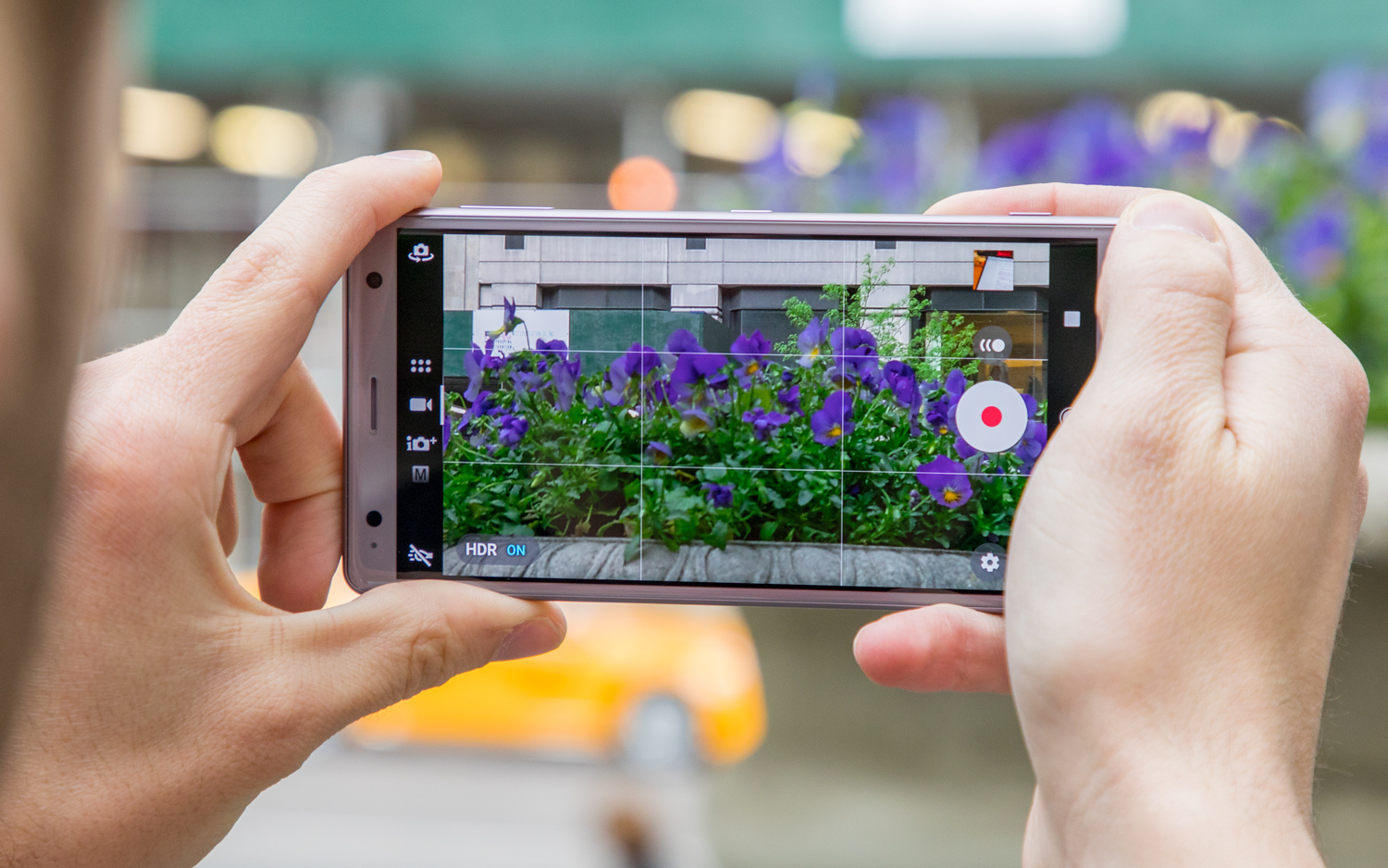
But like most LCD screens, there's not much to say about the XZ2's panel. Sony has provided three display modes out of the box, with the standard setting striking a nice balance between ultrarealistic and ultrasaturated. Visibility is maintained well at off-center angles, and the panel gets bright, though not necessarily as bright as other LCD-powered phones, like the LG G7.
That last point is rather disappointing, because the greatest boon to LCD technology in comparison to OLED is supposed to be its brightness. However, we've witnessed that advantage erode in recent years, with the newest OLED-powered handsets like the Galaxy S9+ reaching 630 nits in our testing. That's bad news for the Xperia XZ2, which topped out at a respectable but hardly pace-setting 540 nits on our light meter.
MORE: Best Cheap Unlocked Smartphones
When using its default display profile, the Xperia XZ2 covered 153 percent of the sRGB color space and managed a Delta-E score of 0.51 (where numbers closer to zero are more accurate). By comparison, the Galaxy S9+ reproduced 231 percent, owing to OLED's capacity to paint more-intense colors, but it also presented slightly more realistic hues, with a 0.40 Delta-E result.
Camera: Selfies need work
Although you'll find Sony's image sensors in the best phone cameras, the company's own handsets have never been especially gifted in terms of photography. The Xperia XZ2 seeks to change that with a 19-megapixel, f/2.0 rear lens equipped with electronic image stabilization, in lieu of a mechanical solution like the ones the Galaxy S9 and Pixel 2 employ. It's accompanied by a 5-MP, f/2.2 lens above the display for selfies. And just as in many of Sony's phones, there's a dedicated two-step shutter key on the side for users who prefer that tactile sensation.
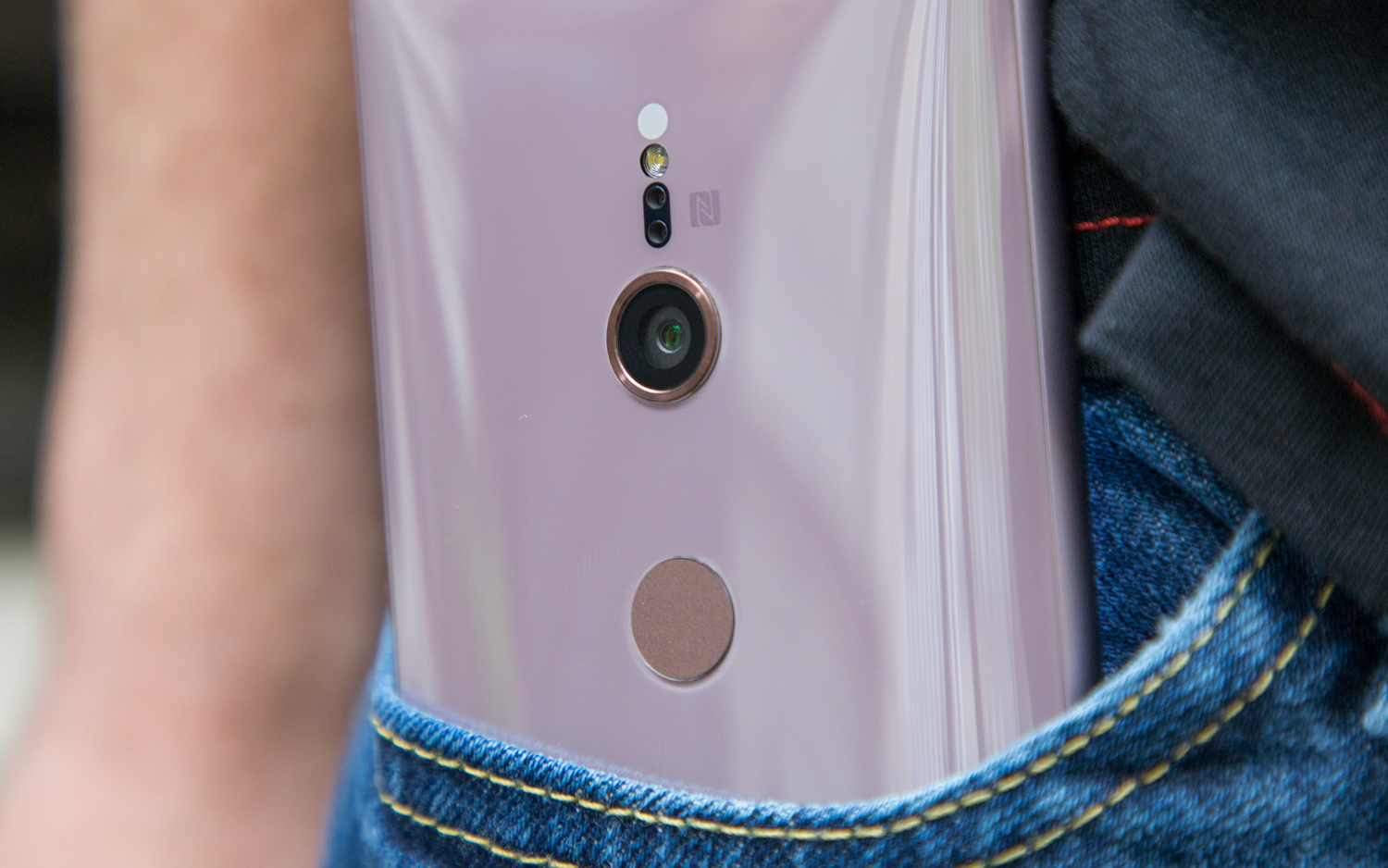
Without a second lens, the Xperia XZ2 can't pull off the kind of bokeh-effect portraits that are all the rage right now. That's a debatable loss, but what stings a little more is the lack of optical zoom. The single-lens Galaxy S9 has similar limitations, so I took both phones out on an expedition to see how they compared.
The Xperia impressed me on an overcast spring morning in Bryant Park, where it pulled out lush shades of greens from the lawn and trees encircling it. The buildings have a bit more warmth to them, too. And while some might attribute the XZ2's brighter sky to overexposure, I can say it's a bit truer to actual conditions. The added sharpness of Sony's 19-MP sensor in comparison to the 12-MP one on the Galaxy S9 also preserves detail in the texture of the grass.
However, Samsung's handset delivered more natural hues when I closed in on a tulip outside a restaurant near the park. A disparity in focal lengths explains the slightly different perspectives both phones opted for here, though the Galaxy S9 deserves more credit for minimizing noise throughout the background — a testament to Samsung's post-processing software that exposes flaws in Sony's own.
The Galaxy S9 also proved to have the advantage in low light, producing a shot in our studio that was surprisingly clear and bright even though all the lights were turned off. Samsung's latest phone is particularly strong in dim conditions, thanks in part to its superwide f/1.6 aperture that lets as much light as possible into the lens. The Xperia XZ2's attempt was significantly darker across the entirety of the frame, and its autofocus took much longer to latch on to objects in the foreground.
Another area where the Xperia XZ2 definitely needs work is its selfie game. Sony's paltry 5-MP wide-angle front-facing camera fell way behind in this round, with an unnaturally cool white balance and crippling pixelation as a consequence of the low-resolution sensor. Compared with what the Galaxy S9 is capable of, Sony's effort is plainly wrong.
Finally, those who like to record slow-motion videos will appreciate the Xperia XZ2's 960 frame-per-second mode — a returning feature from the Xperia XZ1 that the Galaxy S9 also offers.
Like those devices, the XZ2 can record at that speed for a total of 1.2 seconds at 720p resolution, which translates to a 6-second clip when played back in real time. But Sony has also included a 1080p mode this time around, and it's the first of its kind on any smartphone.
That extra sharpness does come with a new limitation, however: The XZ2 can capture a maximum of only 0.6 seconds of 960-fps video at 1080p. In other words, super-slow-mo segments are more detailed, but they last half as long — just 3 seconds when watched. That small window of time makes recording the proper moment frustratingly hard, though the 1.2-second-long 720p mode remains available if you'd rather use it.
While the presence of a 1080p mode at all is commendable, the resulting clips are simply too short to be useful. The added clarity isn't worth the trade-off — especially given that shooting at such high frame rates torpedoes video quality as it is, and the extra pixels don't make that much of a difference. The 720p mode is still the default, and frankly, that's where it should stay until the hardware improves enough to make sustained super-slow-mo recording feasible.
Performance: Another 845 powerhouse
Like all phones packing Qualcomm's latest Snapdragon 845 processor, the Xperia XZ2 is a screamer. Sony's latest phone rivals the LG G7 for the fastest of the flagship Android crowd. Better yet, it does so with just 4GB of RAM, which is rather impressive considering newer devices, like the Galaxy S9+, boast upward of 6GB.
Apps unfailingly opened at the blink of an eye, and switching between them was similarly effortless.
Our unit managed a score of 8,449 on Geekbench 4, a test that measures overall system performance. The G7 edged it out with a score of 8,566, but the Xperia saved its real muscle for 3DMark's Sling Shot Extreme graphics benchmark. There, the XZ2 finished ahead of not only LG's latest offering but also the Galaxy S9 pair, with a result of 4,672 on the OpenGL ES 3.1 segment of the test — some 40 points in front of the S9+ and 200 ahead of the G7.
As those numbers indicate, the XZ2 never stuttered when performing an array of tasks. Apps unfailingly opened at the blink of an eye, and thumbing between them was similarly effortless. I was even able to temporarily jump out of a game of PlayerUnknown's Battlegrounds Mobile to fire off a quick text and return, without experiencing any lag — a challenge that trips up even the most powerful hardware.
Battery: Long-lasting with great software
In an age when most premium-phone makers don't appear to be terribly concerned with extending the longevity of their phones (looking at you, Apple and Samsung), Sony has made a habit of prioritizing battery life. And that's precisely why we came away so disappointed with last year's Xperia XZ1, which put in just 9 hours and 45 minutes of work when endlessly streaming websites over T-Mobile LTE in our battery test.
Thankfully, Sony turned everything around in time for the sequel. The Xperia XZ2's battery is much larger than its predecessor's — 3,180 mAh versus 2,700 mAh — helping it last an impressive 11 hours and 47 minutes in the very same test. That's 2 hours longer than the outgoing model and very close to the Pixel 2 XL, which lasted 12:09.
MORE: Smartphones with the Longest Battery Life
The Xperia XZ2's battery should also perform like new further into the device's life span, thanks to two technologies: Qnovo Adaptive Charging, and Battery Care. Qnovo Adaptive Charging modulates the charging process based on battery health, which it monitors in real time. Battery Care pays attention to when and how long you typically leave your phone plugged in — let's say, overnight, when you go to bed — and keeps the battery charged at 90 percent for the duration of the night to prevent stress. Then, right before you wake up, Battery Care takes it the rest of the way to 100 percent.
It's important to note that Battery Care needs to learn your charging patterns before it can properly anticipate when the phone will be unplugged. It's not a feature unique to Sony's handsets; Asus' ZenFone 5 will employ similar software under the misleading moniker "AI Charging." But its inclusion is nevertheless appreciated and should grant owners some peace of mind. If you'd prefer to charge without wires, the Xperia XZ2 is also compatible with Qi induction pads.
Software and Special Features
The Xperia XZ2 launches with Android 8.0 Oreo on board, but you'd be forgiven for failing to notice. Sony's skin atop Google's OS is as simplistic as ever, but it's also barely changed since the days of Marshmallow. This is another aspect of the design that would really benefit from a fresh coat of paint, but perhaps the company is saving that for the UI overhaul rumored to accompany Android P later this year.
It's hard to imagine a less useful way to enhance someone's music-listening experience than with a barrage of offbeat tremors.
Unfortunately, there's a fair bit of bloatware in tow here. You get four Amazon apps — Shopping, Kindle, Prime Photos and Prime Video — as well as a trial of AVG Protection. There's also the usual gamut of Sony's media experiences, like Xperia Lounge, which offers curated content and special promotions. All of these can be disabled but not uninstalled, which is somewhat frustrating, particularly for an unlocked smartphone.
However, none of those features are as confounding as Dynamic Vibration, Sony's new haptic system that utilizes a vibration motor roughly four times larger than the conventional ones found in most phones. On the Xperia XZ2, that motor delivers feedback in sync with bursts of volume from content playing on-screen.
MORE: 10 Reasons Android Beats the iPhone
If it sounds like a gimmick, that's because it is. The vibration itself is certainly more forceful than you're probably used to, but it also feels very imprecise. When I watched the trailer for the new YouTube Red series Cobra Kai, the pulses weren't reserved for the loudest bangs, like they should have been. Rather, they were haphazard and unrelenting, and if I wasn't required to test the feature for the purpose of this review, I would have shut it off immediately.
Playing music was an even more baffling experience, as it's hard to imagine a less useful way to enhance someone's listening pleasure than with a barrage of offbeat tremors. You'd think Dynamic Vibration would find its purpose in gaming, but none of the five titles I tried — from fan-favorite fighter Tekken to arcade racer Asphalt Nitro — made use of the feature.
But Dynamic Vibration's most infuriating trait by far is its lack of contextual awareness. Surely Sony could have devised some way for the phone to tell whether it's lying flat on a surface or in a user's hands. Because it can't, you'll have to manually turn Dynamic Vibration off every time you want to watch a video with the Xperia XZ2 set down — unless you want to risk cracking that precious glass back once it inevitably shimmies its way off a table.
Bottom Line
If you can see past its idiosyncrasies, the Xperia XZ2 is one of the most capable Android phones on the market, with loads of power, a solid if not class-leading camera, and a long-lasting battery bolstered by smart software that aims to keep the device humming along longer than its competitors. It's the kind of improvement Sony desperately needed to make with its high-end phone line, giving consumers another solid option to Samsung, Google and LG devices.
I say "option" because the Xperia XZ2 still looks and feels like an outsider, with its chubby silhouette, its questionably located fingerprint sensor and the curious existence of Dynamic Vibration. Instead of copying the notch and dumping in a litany of features prefaced with the title "AI," Sony went its own way. And even though everything it threw at the wall didn't necessarily stick, the result is more or less a refreshing change of pace — warts and all.
But there's no escaping the numbers, and there's a big one working against the Xperia XZ2's favor: $799. That's a hefty sum to drop on any device, especially when consumers don't have the option of breaking it up over installments through their carriers. Add to that the fact that the Galaxy S9 is about $80 cheaper and boasts a few critical advantages, like a headphone jack and a better display, and it's tough to call Sony's latest handset the logical choice — even if it is a step up from the company's past efforts.
Credit: Shaun Lucas/Tom's Guide
Adam Ismail is a staff writer at Jalopnik and previously worked on Tom's Guide covering smartphones, car tech and gaming. His love for all things mobile began with the original Motorola Droid; since then he’s owned a variety of Android and iOS-powered handsets, refusing to stay loyal to one platform. His work has also appeared on Digital Trends and GTPlanet. When he’s not fiddling with the latest devices, he’s at an indie pop show, recording a podcast or playing Sega Dreamcast.
